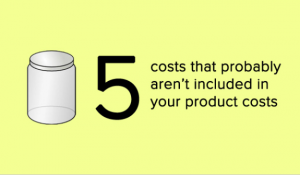
Food product costs.
With food prices increasing this year, now’s the time to conduct an audit of your total food cost to see if you need to make a change. Because, we all know in the food business, if you want to make more money, you can do 1 of 2 things:
1. Cut costs
2. Increase sales
Of course, it’s ideal to do both at the same time. But, today, I’m going to focus on product cost.
But I’m forgetting one crucial step in my planning process. And it’s the most important: your food product cost. I usually calculate my product cost after every production, but with the new year upon us, I wanted to make sure everything from my ingredient prices to packaging and total cost were under control — or at least that I knew them to the penny.
Pennies are super important in your food business. Here’s why: drop your food product cost just 10 cents and here’s what that looks like for the year:
- Units a case: 12
- Savings per case: $1.20
- Sell 100 cases/month: $120
- 1,200 cases a year: $1,200
That $1,200 gets added right to your bottom line (or you could invest in more marketing, too). See why finding your product cost is so important? Even though it’s the most crucial number, a lot of food producers calculate it incorrectly. Hopefully this lists helps you out.
5 costs that probably aren’t in your food product cost:
1. Your Time
I’m just going to address the big elephant in this blog post: your time. Many small food producers write their time off and say it’s just sweat (or sweet :p) equity. Yes, you can do that in the beginning (because it will look like you have better margins), but I’d highly recommend not to. Instead, do this: give yourself an hourly wage – let’s say $15/hour (assuming you were a part-time worker). Determine how many hours it takes to make your product + how many units you make, and you’ve got your labor rate.
Why is this so important?
Because, if you price your product without including labor, you’re not paying yourself for your time. Plus, if you hire a team or ever get your food product co-packed, you’re going to have to incorporate labor, which increases your product cost. This really means, it increases your cost through the distribution channel, all the way to your end customer.
2. Extra Packaging
Do you tie on a bow or add a hang-tag? What about boxing up your online orders or your case boxes for your product. Or, a sneaky culprit: Do you label the outside of your box with another product label to let you know what’s inside? These extra packaging costs not only add up, but they often get shoved under the rug. Inspect your product and write down anything that goes in it. All of those costs are part of your overall product cost.
3. Shipping Costs
Oh, shipping costs. Just when you think you’re getting an out-of-this world deal, the shipping calculator pops up. It may cost you an arm and a leg to ship that special habanero powder across the country, but it’s got to be included in your cost.
4. Pallet fees
When you get your glass delivered, it l, ikely comes on a pallet – even if you’re just getting 30 cases. That $7 pallet fee should be spread across every unit of glass you receive. And while I’m at it, check those glass prices – there was just a 5-7% increase across the board from the major players in the glass industry.
5. Clean-up time
If you rent a kitchen, chances are you get charged time to clean it up. And that costs money. Make sure you factor it into your total cost. It shouldn’t increase it too much is, say, it costs you $25/hour to clean up and you made 800 bottles. It’s a small increase.
Just to reiterate one last time, product cost is super important. Is yours calculated correctly?

Leave A Comment